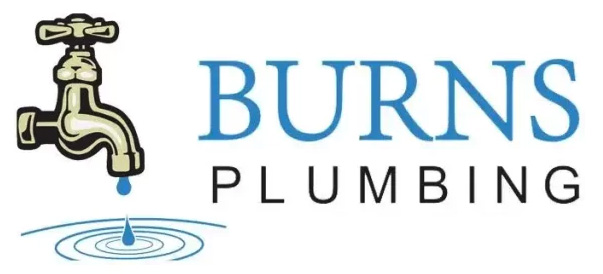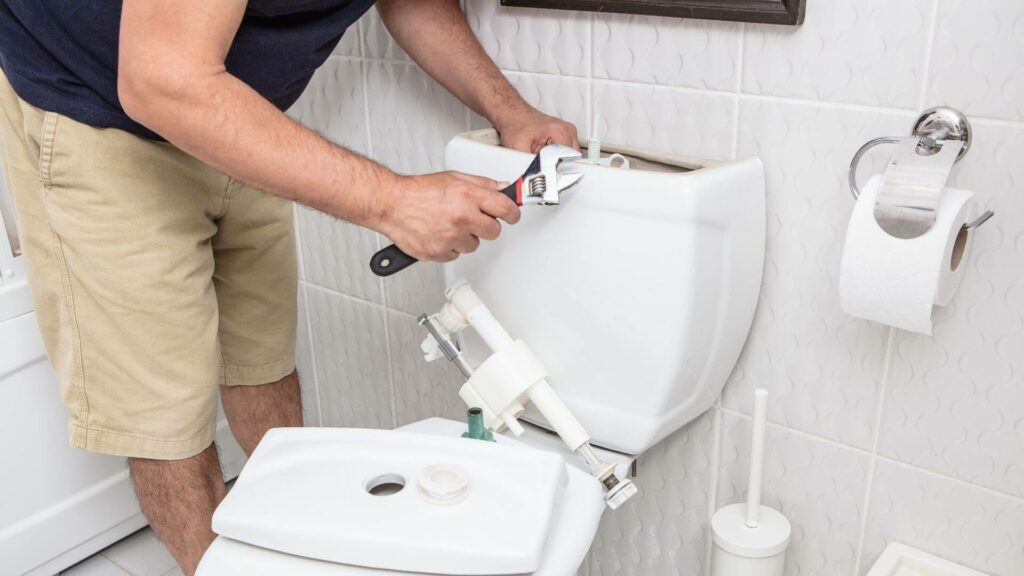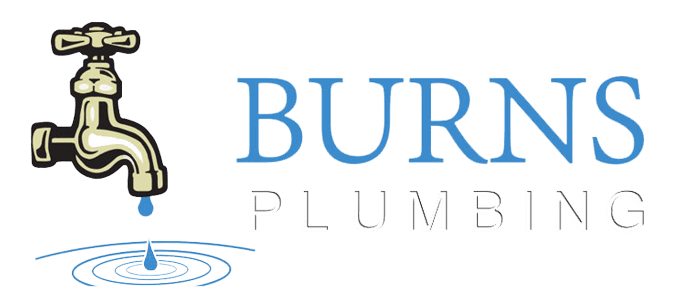A running toilet can be a source of annoyance and unnecessarily high water bills. This guide by Burns Plumbing provides a straightforward approach to diagnosing and fixing a constantly running toilet. By understanding the mechanics inside the toilet tank and bowl, you can stop the wasteful flow of water, reduce your water bill, and prevent water from being wasted.
Whether the issue lies with the flapper valve, overflow tube, or water level in the tank, simple adjustments or replacements can often resolve the problem, ensuring your toilet stops running and functions efficiently once again.
Common Causes of a Running Toilet
A constantly running toilet not only leads to a higher water bill but can also indicate underlying issues within the toilet’s mechanism. Here are the common causes:
- Faulty Flapper Valve: A deteriorated or improperly seated toilet flapper can cause water to leak into the bowl, leading to a constantly running toilet as the tank attempts to refill constantly.
- Misadjusted or Broken Fill Valve: A fill valve that is not properly adjusted or is broken can fail to shut off the water, causing an overflow or continuous flow of water into the tank.
- Overflow Tube Issues: If the water level in the tank is set too high, water may continuously flow into the overflow tube and into the toilet bowl, causing the toilet to keep running.
- Improper Water Level: An incorrect water level in the tank, whether too high or too low, can affect the toilet’s ability to flush properly and stop running after refilling.
- Compromised Valve Assembly: Damage or wear to the valve assembly inside the tank can disrupt the normal flow of water, causing the toilet to run incessantly.
Parts of the Toilet: A Quick Overview
Understanding the different parts of the toilet is crucial for diagnosing and fixing issues that may cause it to constantly run. Here’s a breakdown:
- Toilet Tank: Holds water needed to flush the toilet. Inside the tank, several critical components work together to control water flow and refill after flushing.
- Flush Valve: Located at the bottom of the tank, it releases water from the tank into the bowl when the toilet is flushed and closes to allow the tank to refill.
- Fill Valve: Controls the water flow back into the tank after flushing, shutting off when the correct water level is reached.
- Overflow Tube: Prevents water from overflowing the tank if the fill valve fails to shut off, directing excess water into the toilet bowl instead.
- Flapper Valve (Toilet Flapper): Seals the flush valve opening to keep water in the tank and opens during a flush to allow water to enter the bowl.
- Float: Adjusts the fill valve to start or stop the water flow into the tank based on the water level.
- Tank Lid: Covers the top of the toilet tank.
- Water Supply Line: Connects the toilet to the home’s water supply, delivering water to the fill valve.
- Toilet Bowl: The part of the toilet that receives waste and water from the tank during a flush.
- Wax Seal (Wax Ring): Seals the connection between the bottom of the toilet and the plumbing to prevent leaks.
- Toilet Handle: Initiates the flushing process by lifting the flapper valve when pressed.
How to Diagnose a Running Toilet Problem
Diagnosing a running toilet is the first step to solving the issue and can save you hundreds of gallons of water and reduce your water bill significantly. A toilet that won’t stop running typically has a problem with one of its internal components allowing water to flow continuously. Here’s how to pinpoint the issue:
- Listen and Look: After flushing the toilet, listen for running water and watch the flow into the toilet bowl. If water continues to run without stopping, your toilet has a problem.
- Check the Water Level: Inspect the water level in the toilet tank. If it’s at the top of the overflow tube, it’s too high and can cause water to flow into the bowl constantly.
- Inspect the Flapper: Often, a simple fix like adjusting or replacing a faulty flapper that allows water to flow from the tank to the bowl is all that’s needed.
- Examine the Fill Valve: A malfunctioning fill valve can fail to shut off the water supply, leading to a constant flow into the tank and through the overflow tube.
Identifying the root cause of a running toilet requires observation of how the toilet parts interact and work, ensuring you can target your repair efforts effectively.
Step-by-Step Guide: How to Fix a Toilet That Keeps Running
Once you’ve diagnosed the problem with your running toilet, follow these steps to fix it:
Adjusting the Float to Prevent Constant Running
- Access the Tank: Remove the tank lid and place it away safely.
- Locate the Float: Find the float that controls the water level; it’s usually a ball or cup-shaped device attached to the fill valve.
- Adjust the Float: If the water level is too high, adjust the float mechanism downwards to lower the water level. This can often be done by turning a screw or sliding a clip along a rod.
Replacing the Fill Valve to Stop the Toilet from Running
- Shut Off the Water Supply: Locate the valve behind the toilet and turn it clockwise to cut off the water flow to the toilet.
- Flush the Toilet: Flush the toilet to drain the remaining water from the tank.
- Remove and Replace: Disconnect the water supply line from the old fill valve, remove it, and install a new fill valve compatible with your toilet.
- Adjust the New Fill Valve: Ensure the new fill valve is set to keep the water level below the top of the overflow tube.
Repairing or Replacing the Flush Valve
- Empty the Tank: After shutting off the water supply, flush the toilet to empty the tank of water.
- Remove the Flush Valve: Unscrew or unclip the old flush valve from the bottom of the tank.
- Install the New Valve: Place the new flush valve in, ensuring a tight seal to prevent leaks, and reconnect any chains or hooks to the toilet handle.
When to Turn Off the Water Supply
- Before Any Repair Work: Always turn off the water supply to prevent water from running into the toilet tank as you work.
- In Case of Overflow: If the toilet continues to run and threatens to overflow, immediately shut off the water supply to prevent damage to your toilet and bathroom.
Preventive Measures to Keep Your Toilet Running Smoothly
Maintaining a smoothly running toilet is key to preventing water wastage and ensuring the longevity of your bathroom’s plumbing. Regular checks and simple preventive measures can greatly reduce the risk of a running toilet, saving gallons of wasted water and keeping your water bill in check. Here’s how you can keep your toilet operating efficiently:
- Regularly Inspect the Flapper and Fill Valve: These components are often the culprits behind a running toilet. Check them periodically for wear or damage and replace them if necessary to prevent water from constantly running into the bowl or overflow tube.
- Monitor the Water Level in the Tank: After flushing, observe if the tank refills to the correct level. The water should not flow into the overflow tube; if it does, adjust the float to correct the water level.
- Clean the Toilet Tank and Bowl: Sediment and mineral deposits can interfere with the functioning of the toilet’s internal components. Regular cleaning can prevent issues related to buildup, ensuring proper water flow into the toilet tank and bowl.
- Check for Leaks: A leaking toilet can be caused by issues beyond just a faulty flapper or fill valve. Inspect the tank and bowl for cracks and check the base of the toilet for signs of leaks. A leaking toilet is not only a source of water wastage but can also indicate more severe damage.
- Unclog Regularly: A clogged toilet can affect the flushing mechanism, causing the toilet to keep running. Use a plunger or a plumber’s snake to clear any clogs and ensure free flow into the toilet bowl.
- Replace Old or Inefficient Toilets: If you have an old toilet, consider replacing it with a more water-efficient model. Newer toilets require less water per flush, reducing the risk of running issues and saving water.
By implementing these preventive measures, you can maintain an efficient toilet, stop a constantly running toilet, and mitigate potential issues before they become problematic.
Understanding the Water Supply System in Your Toilet
The water supply system is fundamental to your toilet’s operation, allowing water to flow into the tank and refill it after each flush. Here’s a brief overview of how it works and its importance:
- Water Supply Line: This is the conduit through which water enters your toilet system from your home’s main water supply. A valve controls the flow of water into the toilet tank.
- Fill Valve: Located inside the tank, the fill valve regulates the amount of water used to refill the tank after a flush. It’s connected to the water supply line and opens to allow water in until the float signals it to stop.
- Float Mechanism: This component floats on the surface of the water in the tank. As the water level rises, so does the float, until it reaches a set height that triggers the fill valve to shut off the water supply, preventing overflow.
- Flush Valve and Flapper: When you flush the toilet, the flapper lifts, opening the flush valve. This allows water to flow from the tank into the bowl, flushing the contents of the bowl through the drain. The flapper then closes, and the fill valve refills the tank.
When to Call a Professional Plumber like Burns Plumbing in Sydney
While many running toilet issues can be resolved with DIY fixes, there are situations where calling a professional plumber becomes the wisest choice. Here’s when you should consider reaching out to a plumbing service like Burns Plumbing in Sydney:
- Persistent Running Toilet: If, after trying all standard fixes, your toilet continues to run, a more complex issue might be at play. This could involve deeper plumbing concerns that require professional diagnosis and repair.
- Leaks Around the Toilet: Should you notice water pooling around the base of your toilet or suspect leaks from within the tank or bowl that you can’t pinpoint, it’s time to call in the experts. Leaks can cause significant damage over time and may indicate a need for part replacements or sealing.
- High Water Bills: An inexplicably high water bill might be the result of hidden leaks or inefficiencies in your toilet’s function. Professional plumbers like Burns Plumbing can perform thorough checks to uncover and resolve such issues.
- Major Component Replacement: Replacing major components of your toilet, or the entire toilet itself, might require the expertise and tools of a professional plumber to ensure everything is installed correctly and complies with local building codes.
- Clogs that Won’t Clear: If your toilet is frequently clogged or a plunger doesn’t resolve the issue, it could be indicative of deeper blockages in your plumbing system. Professional tools and expertise are necessary to address these problems effectively.
Give Us a Call Today to Put an End to Your Constantly Running Toilet
If you’re experiencing any of these issues, don’t hesitate to contact Burns Plumbing. With over two decades of experience, our licensed and highly qualified plumbers are equipped to handle any plumbing challenge, ensuring your toilet runs smoothly and efficiently. Save yourself the time, effort, and potential missteps of further DIY attempts—call Burns Plumbing today at (02) 9072 1165 for reliable, expert service in Sydney.


